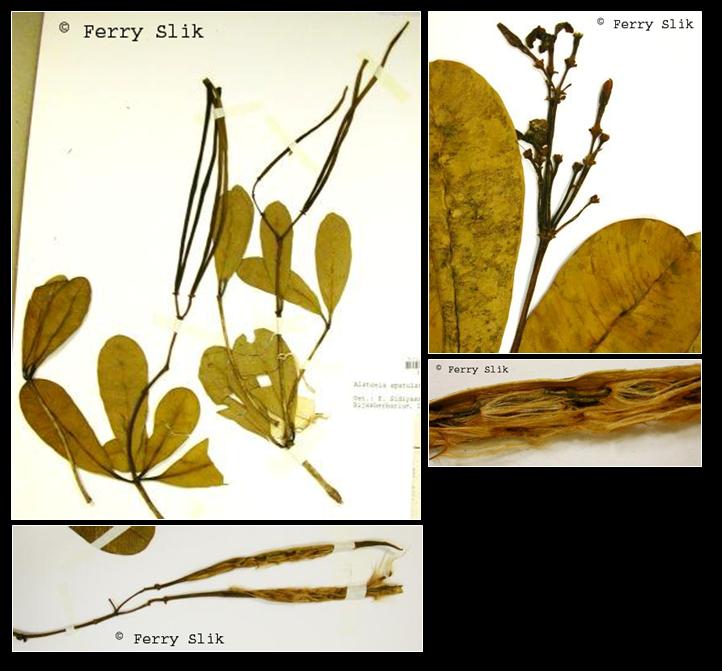Alstonia spatulata Bl., Bijdr. Fl. Ned. Ind. 16 (1826)
Latin for 'spatula shaped'Synonyms
Alstonia cochinchensis Pierre ex Pit.
Alstonia cuneata Wall. ex G. Don.
Diagnostics
Tree with abundant white sap. Leaves in whorls, spoon shaped, no ligule at base of petiole, lower surface
whitish, secondary veins placed close together at perpendicular angle with midvein. Inflorescence with
few flowers only. Fruits very long and narrow, placed in pairs; splitting open to expose many small seeds
with two tufts of hairs for wind dispersal.
Description
A small to medium-sized tree up to 25(-30) m tall, bole at first cylindrical, becoming fluted and shortly
buttressed at the base, up to 40(-75) cm in diameter, outer bark grey, smooth, coming off in small papery
flakes, inner bark pale yellow, with copious latex; leaves in whorls of 3-4(-5), spathulate or obovate,
3-12 cm x 1.8-4.8 cm, apex rounded, with 20-35(-40) pairs of secondary veins, petiole 4-10(-15) mm long;
inflorescence few-flowered, pedicel 4-9 mm long, calyx glabrous, corolla glabrous outside; follicles glabrous,
ca. 200 mm long, dehiscent, placed in pairs, exposing many small wind dispersed seeds when open. [from PROSEA]
Ecology
Occurs scattered on poorly drained, frequently flooded, clay-rich alluvium and on gley soils on undulating
land, particularly near streams, usually below 300 m altitude. It is often abundant in secondary or shrub
vegetation.
Uses
In Indonesia, an aqueous extract of the bark is used throughout West Sumatra as a natural remedy for
diabetes mellitus. In Sarawak, the latex is applied to sores and skin diseases. An extract of the pounded
bark is an ingredient of febrifuges and vermifuges. The wood is used as pulai. The wood of the roots is
used for pith helmets, rafts, rafters for fishery and as a replacement for cork. Exudate used to make
chewing gum.
Distribution
Birma, Indo-China, Thailand, Peninsular Malaysia, Sumatra, Java, Borneo and New Guinea.
Local names
Borneo: Lame, Pulai, Pulai banang, Pulai basung, Pulai kapas, Pulai paya, Pulai rawa.
English: Milkwood.
Indonesia: gabusan (Sundanese), pulai gabus (Palembang, Bangka), lame (Kalimantan).
Malaysia: pulai, pulai basong (Peninsular), pulai paya (Sarawak).
Thailand: thia, sia, tinpet phru (peninsular).
Vietnam: s[uwx]a l[as] b[af]ng, m[ows]p, m[of] cua n[uw][ows]c.
